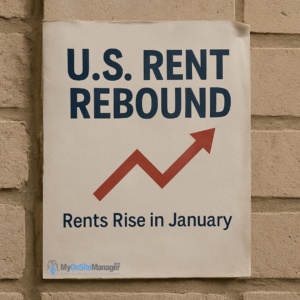After six consecutive months of rent declines, the U.S. rental market showed a notable reversal as rents began to rise again between December 2024 and January 2025. According to Planetizen, this modest but significant increase marks a potential inflection point—one that renters, landlords, and housing policy experts are watching closely.
The End of a Cooling Streak
Throughout much of 2024, renters across the country experienced a rare moment of relief as rental prices cooled, particularly in urban areas where vacancy rates temporarily increased. But that trend came to a halt in January 2025. Rent prices in most metro areas rose, fueled by a tightening rental supply, high interest rates keeping would-be homeowners on the sidelines, and steady demand from an expanding renter population.
For context, national rents had fallen to their lowest levels in three years before this uptick, making January’s shift all the more significant. The increase is small, but its timing—following months of decline—may suggest that the market is stabilizing or possibly beginning a new climb.
Regional Differences Highlight Complex Market Forces
The rental landscape is far from uniform across the United States. While national averages are useful for gauging general trends, the real story unfolds at the local level. In this latest shift, some cities are leading the rent resurgence while others continue to see declines.
-
New York City posted a 5.4% year-over-year increase in rental prices, reinforcing its position as one of the most expensive—and competitive—rental markets in the country.
-
Cities in the Midwest, such as Cincinnati and Milwaukee, also experienced upward rent trends, potentially driven by population shifts and increased demand in secondary markets.
In contrast:
-
Austin, TX saw a 5.4% decline in rental prices, extending its rental market cooldown to 19 consecutive months. This trend is largely credited to successful zoning reforms that allowed more housing units to come online, easing the pressure on rents.
-
Raleigh, NC, another city that’s rapidly added new units, reported a 3.5% decrease in rents.
These variations reflect how local policies, housing supply, and economic dynamics play a major role in shaping rental trends.
Why Are Rents Rising Again?
Several interconnected factors help explain the sudden rise in rents:
-
High Mortgage Rates: With mortgage interest rates still elevated, many Americans are postponing home purchases and continuing to rent. This prolonged stay in the rental market adds pressure to available units.
-
Limited For-Sale Inventory: A shortage of affordable homes for sale makes it harder for renters to exit the rental market, further tightening demand.
-
Delayed Construction: In many cities, new housing developments have been delayed or scaled back due to high construction costs and interest rates, constraining future rental supply.
-
Job Growth in Urban Areas: As the economy improves, more people are relocating for work, often to major metros where rental competition is fierce.
-
Seasonal Factors: The winter months typically see a lull in rental activity, but the early-year bounce could signal that demand is picking up sooner than expected in 2025.
What This Means for Renters
For renters, the rebound in prices could mean the window of opportunity for securing lower rents is beginning to close—especially in high-demand cities. While some regions are still seeing lower prices due to increased supply, tenants in other areas may soon face renewed competition and fewer deals.
Additionally, this shift could impact:
-
Lease Renewals: Tenants approaching renewal may be hit with higher rent hikes.
-
Budgeting: Renters may need to allocate more of their income toward housing, reviving concerns about being rent-burdened.
-
Relocation Plans: Some renters may reconsider moves to pricier urban cores if affordability becomes a bigger issue.
The Policy Outlook: What Can Be Done?
The situation in Austin offers a compelling case study in how housing policy can influence affordability. Zoning reforms and efforts to boost supply have directly contributed to declining rents there—something other cities might look to replicate. Policymakers aiming to stabilize housing costs should consider:
-
Upzoning to allow more multifamily development
-
Streamlining permitting processes
-
Investing in affordable housing initiatives
-
Supporting rent relief programs for vulnerable renters
With housing affordability already stretched in many parts of the country, this moment presents a critical opportunity for local governments to proactively address supply constraints before rent inflation picks up speed again.
Final Thoughts
The January 2025 rent increase may be a small shift numerically, but symbolically, it signals that the renter’s market of 2024 may be behind us. Whether this is a short-term blip or the beginning of another prolonged climb remains to be seen. For now, the takeaway is clear: renters should remain vigilant, cities must double down on housing supply, and the market continues to evolve in unpredictable ways.
Read the original article on Planetizen: Rents Rose Between December and January

